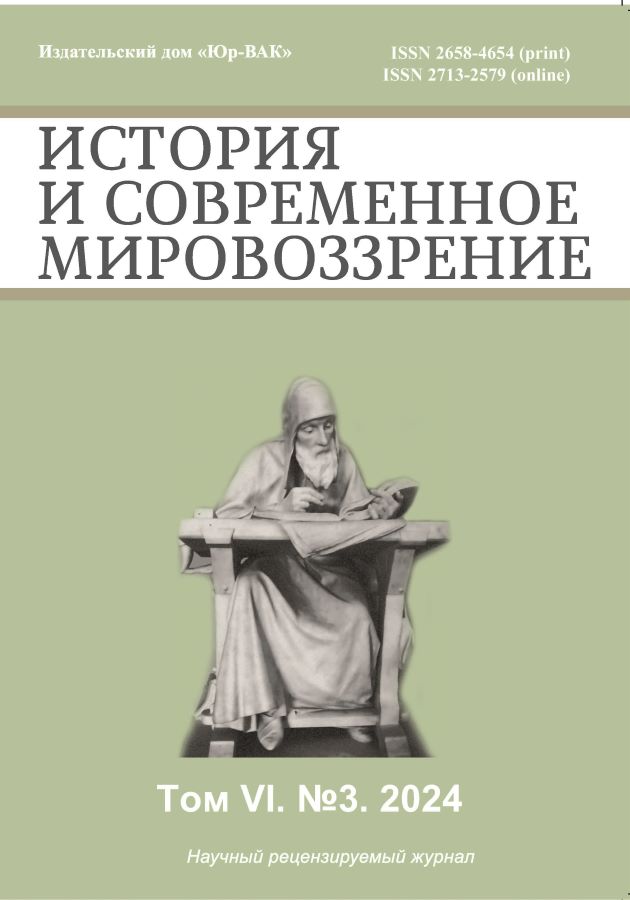Electronic historical sources: definition, classification, physical essence, specific characteristics
- Autores: Yumasheva J.Y.1
-
Afiliações:
- DIMI-CENTER, LLC
- Edição: Volume 6, Nº 3 (2024)
- Páginas: 21-28
- Seção: DEBATING ISSUES OF HISTORY
- URL: https://journals.eco-vector.com/2658-4654/article/view/646655
- DOI: https://doi.org/10.33693/2658-4654-2024-6-3-21-28
- EDN: https://elibrary.ru/EHMFCI
- ID: 646655
Citar
Texto integral
Resumo
The article discusses the problems related to the current state of the methodology of source studies, its development in the context of the information age. The author focuses on the analysis of the historiography created over the past 70 years for the study of electronic documents, electronic files and other types and varieties of digital information, combined by the term «electronic historical sources» (EII). At the same time, the research examines both initially digital (born-digital) and transformed and mixed electronic historical sources that make up the modern source base of most historical and source studies. The article formulates the definition of the concept of «electronic historical sources»; their place in source classifications is determined (EII are positioned as an independent type of historical sources); their general physical characteristics and specific distinguishing features are described, requiring the development of new methods and techniques for scientific criticism of sources of this type, as well as the expansion of research skills and tools through the widespread use of information technology. The author analyzes the experience of document management and archival science, disciplines close to source studies, which were the first to encounter electronic documents and files and have already developed certain approaches and methods of working with these objects. Based on the results of studying extensive domestic and foreign historiography, the author comes to the conclusion that it is necessary to integrate the methods and techniques of these disciplines into modern source studies in order to enrich the tools of source criticism and its adaptation to the conditions and specifics of the information age and new types and types of historical sources.
Texto integral
Sobre autores
Julia Yumasheva
DIMI-CENTER, LLC
Autor responsável pela correspondência
Email: Yumasheva@dimi.ru
Dr. Sci. (Hist.), Deputy General Director for Scientific and Methodological Work
Rússia, MoscowBibliografia
- Astakhova T.S., Chadaeva E.P. Electronic digital signature as a factor in preserving the integrity and authenticity of a document // News of the Tomsk Polytechnic University. 2012. No. 6. Pp. 153–157.
- Borovkova O.V. Electronic historical source: problems and opportunities // Historical, philosophical, political and legal sciences, cultural studies and art criticism. Questions of theory and practice. Tambov: Diploma. 2014. No. 9 (47): at 2 p.m. I. Pp. 26–28.
- Vladimirov V. N., Tsyb S. V. Source studies in the age of the computer (instead of a preface) // in: Source. Method. Computer. Barnaul. 1996. Pp. 3–7.
- Zalaev G.Z. Media for archival storage of electronic documents: state and prospects // Samara archivist. 2019. No. 4. Pp. 5–9.
- Zalaev G.Z. Analysis and classification of electronic documents // Herald of an Archivist. 1999. No. 2–3. Pp. 62–65.
- Zlobin E.V. Machine-readable documents as a historical source. Moscow: Military University of the Ministry of Defense of the Russian Federation. 1999. 168 p.
- Kovalchenko I.D. Methods of historical research. M.: Nauka. 2003. 485 p.
- Kozlov V.P. The life of the document // Office work. 2013. No. 1. Pp. 11–17, No. 2. Pp. 6–12.
- Sabennikova I.V. Cloud services for storing digital documents: the legislative framework and existing risks // History and archives. 2022. No. 2. Pp. 73–82.
- Sabennikova I.V. Electronic documents in the information exchange system of archives // Herald of an Archivist. 2021. No. 2. Pp. 520–531.
- Surovtseva N.G. Authenticity and identity of an electronic document // Herald of an Archivist. 2020. No. 2. Pp. 467–477. doi: 10.28995/2073-0101-2020-2-467-477.
- Tikhonov V.I. Will the time of «computer paleography» come? // Information bulletin of the Association «History and Computer». 2002. No. 30. Pp. 114–116.
- Yumasheva Yu.Yu. Actual problems of source studies of the information age // Document. Archive. History. Modernity / Chief editor L.N. Mazur. Issue. 23. Yekaterinburg: Uralsky Fed. University named after the first President of Russia B.N. Yeltsin. 2023. Pp. 109–140.
- Duranti L. The Impact of Technological Change on Archival Theory // Acts of the 14th International Congress on Archives. September 16, 2000. Seville, Spain. Paris. 2001. P. 5 URL: http://www.interpares.org/documents/ld_sevilla_2000.pdf.
- Pacheco A., Da Silva C.G., De Freitas M.C.V. A metadata model for authenticity in digital archival descriptions // Archive Science. 2023 № 23. Pp. 629–673. doi: 10.1007/s10502-023-09422-w.
- Sheridan J. Digital archiving: «Context is everything» // 19 April 2018. URL: https://blog.nationalarchives.gov.uk/digital-archiving-context-everything/.
Arquivos suplementares









